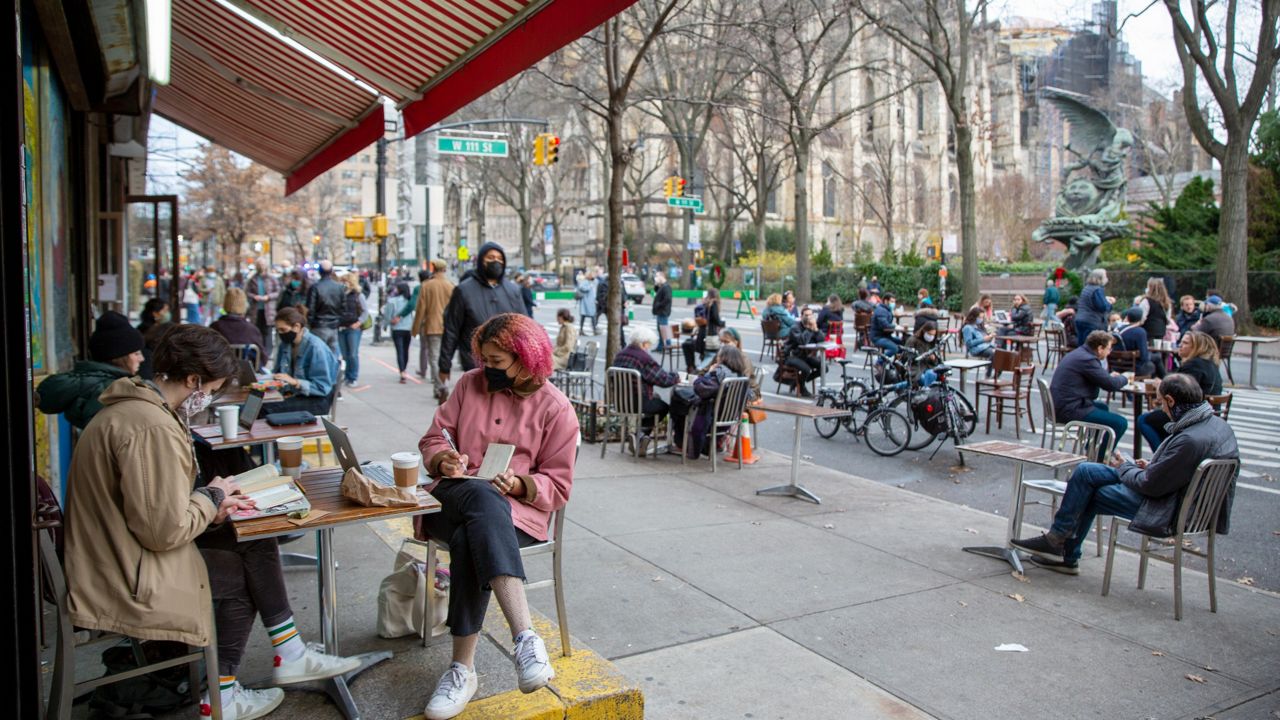When the city went into lockdown as COVID-19 swept through the five boroughs in March 2020, restaurant and bar owners faced a seemingly insurmountable challenge: staying in business with indoor dining off the table.
To expand outdoor space and throw businesses a lifeline, the city devised two plans: an Open Streets program closing select corridors to car traffic and an Open Restaurants program that allowed eateries to serve diners on sidewalks and streets.
A report released by the city’s Department of Transportation on Tuesday found the Open Streets program, which launched in May 2020, pushed some bars and restaurants’ sales above pre-pandemic levels, encouraged new eateries to open and stopped many existing ones from shuttering.
What You Need To Know
- A report released by the Department of Transportation on Tuesday found the city's Open Streets program "provided a vital boost to restaurants and bars during the pandemic"
- Analysts examined state tax data to evaluate three “key metrics”: the change in the number of bars and restaurants on each street, how many eateries managed to stay open and how their sales grew over time
- The report found the program pushed some bars and restaurants’ sales above pre-pandemic levels, encouraged new eateries to open and stopped many existing ones from shuttering
“With the street closure, restaurants and bars were able to attract more customers by adding more tables and chairs, which translated to greater revenues,” the report said.
“With these findings, it is clear that the Open Streets program provided a vital boost to restaurants and bars during the pandemic,” the report added. “Many participants in the program have noted that without Open Streets, their businesses would have very likely closed permanently.”
The study, developed by the DOT, the city’s Department of Finance and consulting firms Bloomberg Associates, founded by former Mayor Michael Bloomberg, and Bennett Midland, compared five streets that took part in the program to similarly situated “control corridors” — streets that remained open to vehicular traffic — analyzing statistics from March 1, 2020 through Aug. 31, 2021.
In Astoria, for example, the study compared an Open Street on Ditmars Boulevard, between 33rd and 36th streets, to a “control corridor” on Ditmars Avenue, between 28th and 33rd streets.
The analysis also compared and contrasted Open Streets and “control corridors” in Chinatown, Koreatown, Park Slope and Prospect Heights, the report said.
Analysts examined state tax data collected by the DOF to evaluate three “key metrics”: the change in the number of bars and restaurants on each street, how many eateries managed to stay open and how their sales grew over time.
Bars and restaurants across the city saw a more than 50% drop in sales during the first year and a half of the COVID-19 pandemic, with Manhattan sales standing at 22% below pre-pandemic levels by the summer of 2021, according to the report.
Eateries that found themselves operating on Open Streets, however, “recovered most quickly,” the report found.
“Open Streets corridors were an average of 19% above their pre-pandemic baseline, while control corridors were 29% below, a difference of nearly 50%,” the report said.
The study also found that the Open Streets program did more to boost business than the DOT’s Open Restaurants program, which allowed restaurants to set up curbside outdoor dining sheds.
“In three out of five cases, restaurant and bar sales grew significantly faster on Open Streets than on nearby corridors with high Open Restaurant participation,” the report said. “In the other two cases, the Open Streets and comparison corridors had similar levels of sales growth.”
Open Streets, meanwhile, saw faster increases in the net number of restaurants and bars opening on their blocks than their control counterparts or home boroughs did, according to the report.
“For example, Park Slope’s Open Street on Fifth Avenue saw an 18% increase in restaurants and bars, compared with a 24% drop on Seventh Avenue and a 7% drop across all of Brooklyn,” the report said.
And the Open Streets analyzed in Chinatown and Koreatown “retained 86% of pre-existing businesses, compared with just 67% on the control corridors,” according to the report.
At a news conference Tuesday morning, DOT Commissioner Ydanis Rodriguez said the city planned to add more corridors to the Open Streets program.
“Yes, the future of New York City is going car-free,” Rodriguez said in response to a reporter’s question. “We will continue expanding Open Streets.”
His pledge came despite criticism from drivers who say the Open Streets program has made it harder to find parking and traverse the city by car.
In a statement, Mayor Eric Adams said the Open Streets and Open Restaurants programs “helped keep our restaurants and the city’s economy afloat” when the COVID-19 pandemic hit.
“This report echoes what we have heard in communities across the city: Opening our streets can kickstart small businesses, create jobs and lift up neighborhoods,” Adams said. “And as New York City comes back, this program will continue to be a critical driver of a strong, equitable recovery.”



